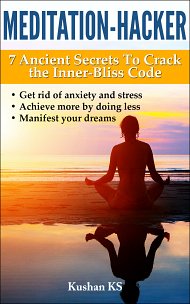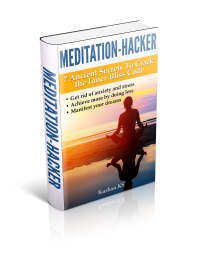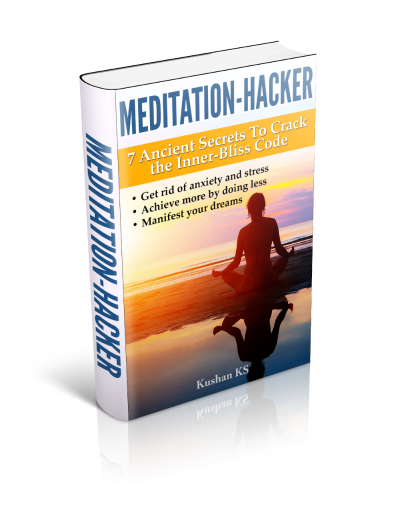How to Meditate for Beginners - Beginner Meditation
"So don't be in a hurry and try to push or rush your practice. Do your meditation gently and gradually step by step. We must find our own practice and persistently keep at it"
- Ajahn Chah

In this final section of the three-part How to Meditate for Beginners, we will talk about a simple beginner meditation.
It is used widely across meditative traditions and through all levels from novice to most advanced students, and is probably the best practice to begin with.
I am referring to breathing meditation or breath-counting meditation.
Its attractiveness lies in its remarkable simplicity and ease of learning. It doesn't require any special mantra, object, visualization, complicated ritual or complex instruction to achieve stillness.
Anyone, anywhere, if he or she is still breathing (pun intended), can learn to do it in less than five minutes.
Here is how:
- focus your attention at the tip of your nostrils
- observe the flow of air as you breathe in and out; as you breathe out, count the number 'one' in your mind, then 'two' on your next out-breath and so-on
- do it for a set number of breaths, between 4 and 21
- repeat the exercise
- if your mind wanders, gently bring it back to focus on the breath again
- don't beat yourself up if the mind continually wanders - perfectly natural for it to wander; it happens to everyone
- agitation and dullness will hamper your practice; be gentle and stay on their lookout
- mindfulness and awareness will help your practice; watch your mind and safeguard it from wandering
- remember to focus on the breathing and not on the numbers; if you find yourself captivated by the numbers, then drop them
Breath is a useful tool for meditation, which can be used by anyone because it is non-religious, unlike many mantra or invocation or imagery, one has no difficulty finding it (I do hope so!), and it is an entirely natural process.
I would also like to introduce another beginner meditation, as taught by Paramhansa Yogananda (the Autobiography of a Yogi).
This pre-supposes a belief in God, so if you are an atheist, feel free to skip it.
Alternatively, you could dedicate your prayer to the all-giving Nature around us.
- begin by offering God a prayer from your heart, expressing your devotion and asking His blessings on your meditation
- tense and relax to remove all stress (similar to progressive muscle relaxation mentioned earlier)
- inhale, tensing the whole body and clenching the fists. Relax all the body parts at once and, as you do so, expel the breath through the mouth in a double exhalation, "huh, huh"
- repeat this practice three to six times
- then forget the breath. Let it flow in and out naturally, of its own accord, as in ordinary breathing
- focus attention at the spiritual eye (point between your eye brows) with the eyelids half closed (or completely closed, if this is more comfortable to you)
- look upward, focusing the gaze and the attention as though looking out through a point between the eyebrows (a person deep in concentration often "knits" his brows at this spot)
- do not cross the eyes or strain them; the upward gaze comes naturally when one is relaxed and calmly concentrated
- what is important is fixing the whole attention at the point between the eyebrows
- this is the Christ Consciousness center, the seat of the single eye spoken of by Jesus: "The light of the body is the eye: if therefore thine eye be single, thy whole body shall be full of light" (Matthew 6:22)
- when the purpose of meditation is fulfilled, the devotee finds his consciousness automatically concentrated at the spiritual eye, and he experiences, according to his inner spiritual capacity, a state of joyous divine union with Spirit
- it takes deep concentration and calmness to behold the spiritual eye: a golden halo surrounding a circle of blue, in the center of which palpitates a five-pointed white star
- those who do see the spiritual eye should strive to penetrate it by deeper concentration and by devoted prayer to God
- silently chant and pray to God, keeping the attention at the point between the eyebrows, until you feel God's response as a calm, deep peace and inner joy
- daily practice should last at least thirty minutes in the morning and thirty minutes at night
- the longer you sit, enjoying the state of meditative calm, the faster you will progress spiritually
- carry into your daily activities the calmness you feel in meditation; that calmness will help you to bring harmony and happiness into every sphere of your life
The beginner meditation above, as given by Yogananda Paramhansa, and the breathing meditation are great starting blocks to build your meditation practice upon.
You can also explore other meditation techniques for beginners to further deepen your practice. Also, these basic meditation exercises that trigger the relaxation response, similar to PMR, will help you enter the meditative state easily.
<Progressive Muscle Relaxation
Return from Beginner Meditation to Beginners Guide

Get my book, Meditation-Hacker: 7 Ancient Secrets to Crack the Inner-Bliss Code and receive valuable information on meditation that you can use to improve the quality of your health and life.


Comments
I would love to hear your meditation experiences. And, if you are a beginner, your questions and apprehensions about meditation. Comment below or contact me directly through the navigation bar on the left of this page.